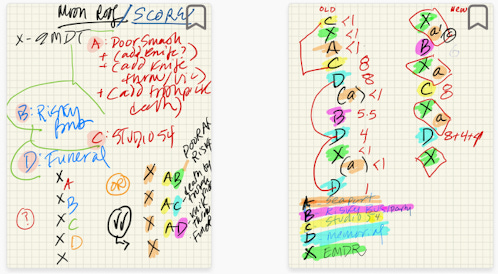Multidimensional Story Mapping, part 1
not your mother's beat sheet
MULTIDIMENSIONAL MAPPING
Beat sheets are plotting tools that help writers lay down and structure storylines. In the film and tv world they are crucial documents that facilitate collaboration between creatives from writers to directors and show runners. Breaking down story this way has been done since time immemorial, long before Aristotle, who was one of the first western thinkers to codify ideas about narrative structure in writing, in the Poetics.
There are quite a lot of well known and commonly used such templates out there -- the Hero one, the Cat one, you can find more. I encourage you to explore any relevant or interesting templates but also to go off template, if you're at all tempted to. After all, if you are reading my Substack, you probably aren't here to stamp out widgets.
Over the next few posts, I'll discuss an approach to story mapping that blends the beat sheet idea with some other dimensions. It's a strategy that can be useful at any phase of writing, whether you're developing and writing an initial draft of a story, editing or restructuring a subsequent draft. Even (and perhaps especially) for writers who don't yet know the order of events in their story, how it ends, or quite everything that will go into it, this method should be useful because it can be done modularly and the outcome used to determine story structure.
A basic overview of my mapping strategy follows, and a template / worksheet is attached. You can upload or adapt and remake it to fit your specific text. Elements of it could certainly be turned into a spreadsheet, but I strongly recommend you go analogue with this project, if you decide to try it.
Inventory and color code 6 - 10 narrative elements to help you track and take control of opportunities for rhythm and patterning. Use this same color coding in making the subsequent documents.
Make a chronology, documenting key events (ranging from the stone age to the latest point in time you cover), using calendar time.
Draw a graphic rendition of the story as you understand it, at this point, and try to include secondary or other plot lines.
Start a beat chart organized by the order of telling, the order in which events unfold on the page. The left hand column will be a scene or "moment" inventory. Try the template in the attached pdf, or make your own.
Continuing with your color legend, map out most important narrative elements that occur in each scene, using categories such as character, point of view, place, weather, motif, flashback and the inclusion of non-dramatic passages such as found texts, world building or introspection .
Draw maps of the terrain, pictures of characters or objects, family trees and anything else you think will help you.
This is kind of a big document, that could take a while, if you decide to do all the steps, especially on a book-length manuscript. Do whatever helps you and no more. Over the next week or two, I'll be posting in more detail about each step of the Multidimensional Map method, so stay tuned if this may be helpful for you.
Good writing!



